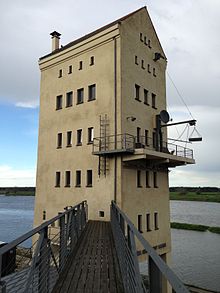Loading tower

A loading tower (also loading tower ) is a high - storey , tower-like , massive industrial building that, with the appropriate technology, is able to lift goods from the ground, from road , rail and / and water vehicles and to turn them alternately .
Construction
A loading tower is a multi-storey building and has external and internal handling technology as well as internal floors and rooms.
Loading towers were installed at permanent, stationary transshipment locations, e.g. B. in ports .
Due to their design, the loading towers combined the functions of cranes, loading bridges and bulk goods pumps.
From the beginning of industrialization from the end of the 19th and 20th centuries, loading towers were erected at stationary transshipment locations, where the technology and the locations of loading and unloading of the various vehicles remain the same and therefore less mobile (mobile) cranes , excavators and pumps would be effective. They were widely used in ports.
Handling technology
Loading towers usually had several fixed or movable booms that carried rope hoists, crane arms or pump or suction pipes. Due to the statics of the loading towers, high and expansive handling equipment could be installed. In this way, the more distant locations were reached by ships, freight trains and road vehicles.
In the case of general cargo , it usually involves rope hoists and cranes, while bulk cargo involves excavators, pumps and suction devices. For this purpose, a loading tower has fastenings attached to the building, movable and immovable booms and / or suction and pressure lines.
More functions
Goods could be stored protected from the weather on mezzanine floors. It was also possible to transport them from the loading tower to other storage facilities using conveyor belts . Light bulk goods (mostly grain) were transported from or to nearby silos via conveyor bridges .
A loading tower offers the possibility of setting up closed, weather-protected rooms for lifting technology, the storage of handling and operating materials, for the connection of further transport technology (e.g. conveyor belts, pipelines, etc.) and for setting up work or even stay - and living spaces.
Examples
- Loading tower Groß Neuendorf ( District of Märkisch-Oderland , State of Brandenburg )
- Loading tower of the grain silo in the Elbe industrial port Magdeburg (State of Saxony-Anhalt )